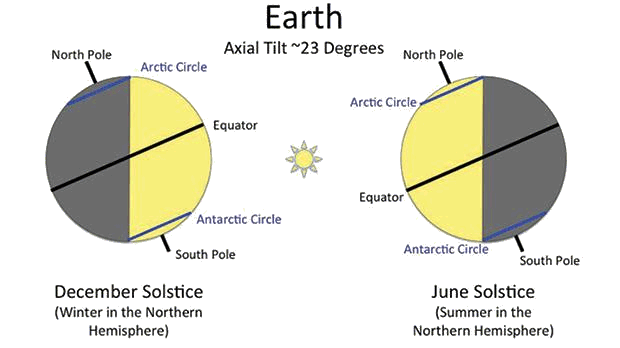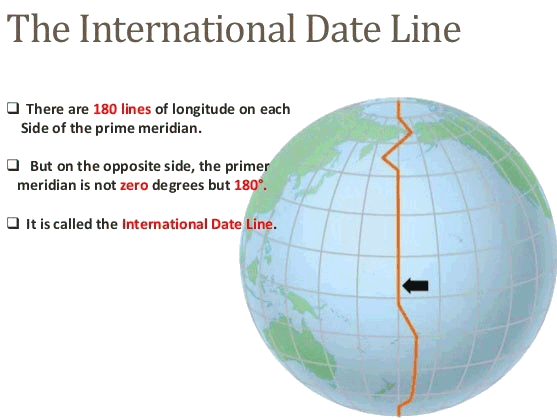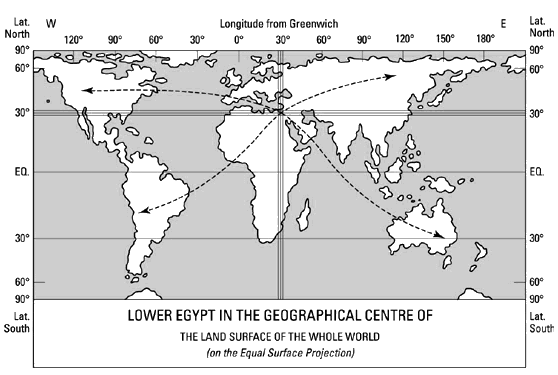|
Patrick Moore begins this chapter by
stating that while the earth is of
course important to us... it's a
very ordinary planet.
The size
is normal enough:
It has a diameter (the book claims)
or 12,756 km as measured through the
equator, but only 12,709 km as
measured through the poles, so that
it is what is technically as an
oblate spheroid, rather than a
perfect sphere.
It's
hard to corroborate those dimensions
with
Wikipedia as there they are
given as radii:
Equatorial radius: 6,378.137 km
Polar radius: 6,356.752 km
I do
wonder if there is a discrepancy
(the latter gives a diameter of
12,713.504) due to measurements
being updated through a more
accurate means.
Perhaps the Wikipedia page on the
World Geodetic System (WGS)
has the answer:
[WGS] is a standard for use in
cartography, geodesy, and
satellite navigation including
GPS. This standard includes the
definition of the coordinate
system's fundamental and derived
constants, the normal gravity
Earth Gravitational Model (EGM), a
description of the associated
World Magnetic Model (WMM), and a
current list of local datum
transformations...
All components of WGS84 [the
present version] are regularly
updated. ... Its Definition and
Relationships With Local Geodetic
Systems document, initially
published in 1984, has been
revised in 1997, in 2004 ... and
finally in 2014 ... The
regularly-updated documents
provide refined descriptions of
the Earth and realizations of the
system for higher precision.
The
bulging at the equator is because
the earth is rotating on an axis.
|
For comparison,
Mars has the following
dimensions (according to
Wikipedia):
Equatorial
radius: 3,389.5
Polar radius: 3,376.2 |
The
orbit around the sun is also not
circular; as Johannes Kepler showed,
it is an ellipse, with the sun lying
in one focus.
| The ellipse
produced by the orbit actually
has two foci. |
Kepler,
under the direction of
Tycho Brahe, was trying to
understand and calculate the orbit
of Mars. Things weren't adding up
with either a circular or egg-shaped
orbiit. Then in late 1604 he at last
hit upon the idea of an ellipse,
which he had previously assumed to
be too simple a solution for earlier
astronomers to have overlooked.
Finding that an elliptical orbit fit
the mars data, [he] immediately
concluded that all planets move in
ellipses, with the Sun at one focus
- his first law of planetary motion.
When
Earth is closest to the Sun
(perihelion) the separating distance
is 147,000,000 km, at its furthest
(aphelion) it is 152,000,000 km,
giving a mean of 149,598,500 km, or
one astronomical unit (AU).
| You might
think that winter occurs when
the earth is closes to the
sun, but you'd be mistaken.
The seasons are due to the
tilt of the earth's axis [link]. |
It takes
the Earth 365.256 days (rotations on
its axis) to complete one orbit of
the Sun. This is slightly longer
than our calendar year, which is why
we have Leap Years where February
includes an extra day every four
years.
The
earth's atmosphere is made up of 78%
nitrogen and 21% oxygen. The
remaining 1% includes other gasses
such as argon and carbon dioxide.
The atmosphere extends upward for
hundreds of kilometers, but most of
it is concentrated in the lowest
layer, known as the troposphere.
This layer lies between sea-level
and a mean height of 8 km over the
poles and 11 km over the tropics.
This is where we find all our
'weather', and all ordinary clouds.
There is very little trace of
atmosphere left above a height of
1000 km.
The
atmosphere is unsteady and,
according to Patrick, this is what
makes the stars twinkle. However,
this doesn't seem like a
satisfactory explanation unless the
visible planets are within our own
atmosphere!
earthsky.org says this:
Stars
twinkle because … they’re so far
away from Earth that, even through
large telescopes, they appear only
as pinpoints. And it’s easy for
Earth’s atmosphere to disturb the
pinpoint light of a star. ...
Planets shine more steadily
because … they’re closer to Earth
and so appear not as pinpoints,
but as tiny disks in our sky.
Water
vapour in the high part of the
troposphere may split up the
sunlight and cause rainbows.
Sometimes a thin layer of
ice-crystal cloud will make the Sun
and the Moon produce a halo.
It is
the atmosphere which scatters the
blue part of the Sun's light around
to make the sky blue. When the sun
is low down, more of its red rays
can pass unchecked.
"In
astronomy the term 'day' is taken to
mean the whole 24-hour period, not
just he interval between sunrise and
sunset." Coincidentally, in reading
The Book of Ceremonial, some
prayers are given with the
instruction that they are to be said
during the first hour of the day;
does it mean immediately following
sunrise?
The
"march of the seasons... have very
little to do with the Earth's
changing distance from the Sun, and
we are actually at our closest to
the Sun in December, when it is
winter in Britain... [It is the tilt
of the] Earth's axis... the angle
between the axis and the
perpendicular is 23o26',
or approx. 23.5o. In
June, the Earth's north pole is
tilted toward the Sun, and the
northern hemisphere receives the
full benefit of the... rays... By
December the conditions have been
reversed."

When we
want to give the position of any
point on the Earth's surface, we do
so by quoting its latitude and
longitude.
Latitude
is simply the angular distance of
the point from the Earth's equator
reckoned from the centre of the
globe (the latitude of the equator
being 0o)
Longitude is the angular distance of
any point east or west of the
Greenwich meridian.
To
understand what a meridian is we use
the term great circle.
The
Greenwich meridian [the Prime
Meridian] is the great circle on the
Earth's surface which passes through
both poles and also through
Greenwich. Longitude is measured up
to 180o east and west.
The longitude line on the opposite
side of the world runs largely
through the Pacific Ocean, missing
New Zealand by a fairly wide margin.
This is also known as the
International Date Line.

Geographic poles are not the same as
the magnetic poles; magnetic
compasses do not indicate true
north. [Indeed, the magnetic pole
shifts]
|
 From
the book The Atlantis
Blueprint by Rand Flem-Ath and
Colin Wilson (which I read in
2014): From
the book The Atlantis
Blueprint by Rand Flem-Ath and
Colin Wilson (which I read in
2014):
In October
1884, Professor Charles Piazzi
Smyth, the Astronomer Royal
for Scotland, was involved in
a controversy on a matter dear
to his heart: persuading a
committee of experts from
twenty-five countries of the
world to make the north–south
line that ran through the
Great Pyramid the prime
meridian of the world, 0
degrees longitude.
It may sound
odd that, towards the end of
the nineteenth century, when
great steamships had been
plying the oceans for decades,
such a question should remain
undecided. There had been
numerous prime meridians –
virtually one for every
country that used the sea...
Charles II of England decide[d]
to build the Greenwich
Observatory, with the
intention of designating
Greenwich as the prime
meridian. The French
disagreed, and then said it
should run through Paris. As
other countries built
observatories, most of them
declared their own capital the
site of the prime meridian,
which is why, in October 1884,
twenty-five European countries
gathered in Washington, DC, to
make a final decision.
Greenwich was
high on the list of candidates
because so many ships used the
port of London, but Smyth was
passionately opposed to it. In
the Report of the Committee on
Standard Time and Prime
Meridian,1 published in
Cleveland, Ohio, in June 1884,
he argued that the Pyramid was
the ideal choice because such
a meridian would pass over
more land than any other.
The Great
Pyramid, he pointed out, was
acknowledged to be the
grandest monument ever
erected. [He also recognised
that the Great Pyramid was
located at the centre of the
earth’s land mass.] As a
further argument, he drew
attention to its closeness to
Jerusalem, evoked the Second
Coming of Christ, and asked
whether every good Christian
would not agree that a Giza
meridian would be ideal.
The answer was
no. The delegates were not at
the conference as Christians
but as scientists.
[When Giza is used as the
prime meridian, as it perhaps
was in the ancient past,
suddenly dozens of sacred
sites (Ballbek, Paracas, Cuzco,
Sidon, Machu Piccu, Ehdin,
Ollantaytambo, Nineveh) ...
fit into a vast global
pattern. It is also said that
into the Great Pyramid are
programmed the dimensions
of the Earth and it's place
upon it.]
 |
"Venus
and Mars have no detectable
[magnetic] fields... [although] the
giant planets have very strong
[magnetic] fields indeed." The
following table is adapted from
www.astronomynotes.com/solarsys/plantblb.htm
|
Planet |
mag. field (* Earth's) |
| Mercury |
0.006 |
| Venus |
0.00 |
| Earth |
1.000 |
| Mars |
0.00 |
| Jupiter |
19,519 |
| Saturn |
578 |
| Uranus |
47.9 |
| Neptune |
27 |
magnetic field
(mag. field) is the total strength (NSSDC
gives strength in #gauss × Rplanet3,
where Rplanet is the
radius of the planet and Earth's
strength = 0.3076 gauss × RE3
= 7.981×1010 gauss...
Because the Earth spins on its axis
from west to east, the bodies in the
sky seem to move from east to west,
taking approximately 24 hours to
complete a full circuit. Yet there
are two points in the sky which do
not seem to move at all; these are
the celestial poles, which lie in
the direction of the Earth's axis.
The north celestial pole is marked
fairly closely by the bright star
which we call Polaris, or the Pole
Star, in the constellation of Ursa
Minor, the Little Bear. There is no
bright star close to the south
celestial pole, and we have to make
do with the obscure star Sigma
Octanis, which is barely visible to
the naked eye...
Although appearing to the naked
eye as a single point of light,
Polaris is a triple star system,
composed of the primary, a yellow
supergiant designated Polaris Aa, in
orbit with a smaller companion,
Polaris Ab; the pair is in a wider
orbit with Polaris B. The outer pair
AB were discovered in August 1779 by
William Herschel. - Wikipedia
--------------
More
coming soon...
[Back
to Top]
|